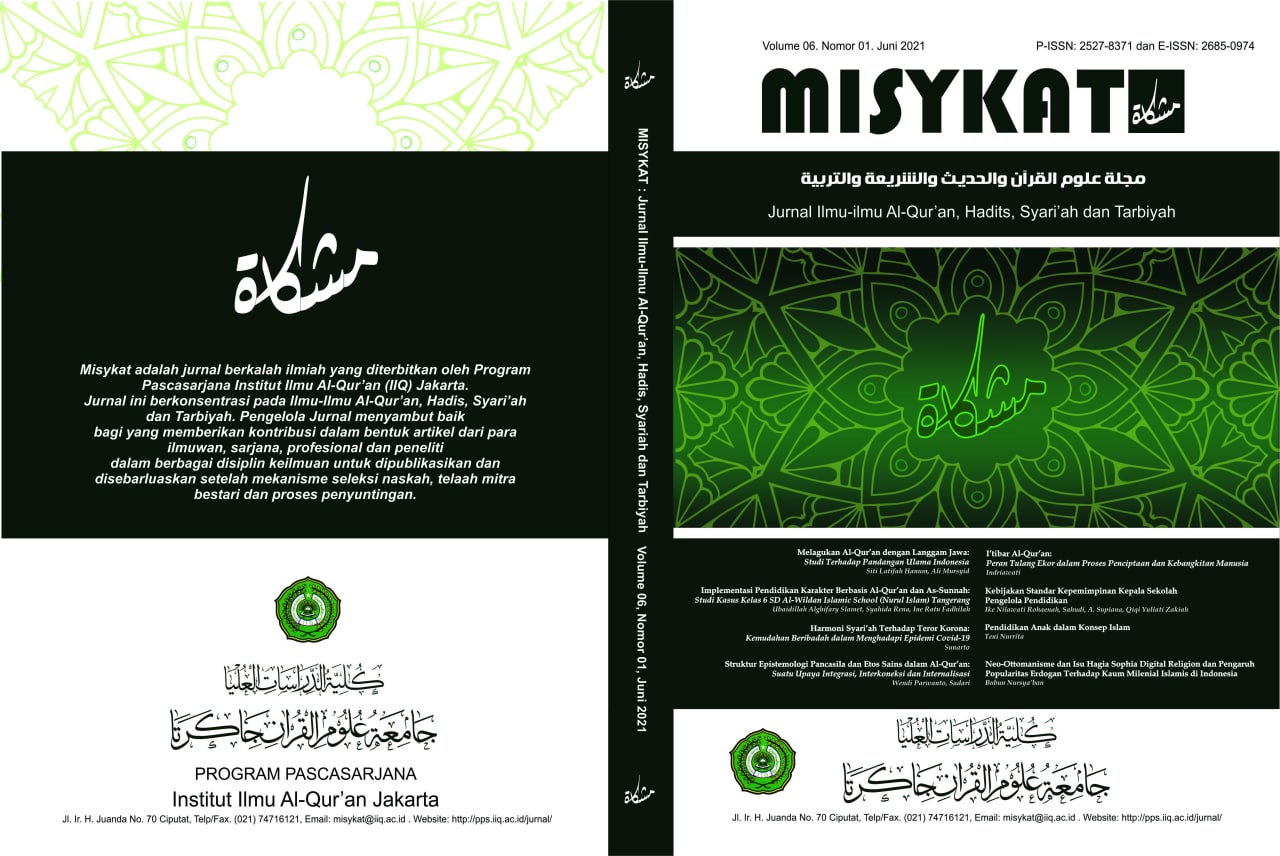TAFSIR AYAT-AYAT KEKERASAN SEKSUAL
Analisis Metodologis Terhadap Penafsiran Kongres Ulama Perempuan Indonesia (KUPI)
Abstract
Data has shown that the number of cases of sexual violence continues to increase, even in educational institutions. Meanwhile Permendikbud No. 30 of 2021 which aims to prevent and deal with sexual violence in universities, even when this article was about to be published in a journal, it was still controversial. In 2017, the Indonesian Women's Ulama Congress (KUPI) was held, which among other things discussed sexual violence. The interpretation of the verses on sexual violence in the perspective of KUPI, among others, states two things: First, sexual violence, whether committed outside of marriage or inside marriage, is haraam. Second, rape and adultery, although both are sexual relations which are prohibited by Islam, they are different. Rape is a hirâbah in which the perpetrator forces the victim to have sex, in this case the perpetrator and the victim are different. The perpetrator committed two prohibited acts at once, namely adultery and coercion. Meanwhile, the victim did not do anything wrong because he was forced, so that the victim of sexual violence should not be equated with the case of adultery, and the victim of sexual violence should be given compensation. These are among the results of the Indonesian Women's Ulama Congress (KUPI) which are written in the KUPI Document. This paper discusses and analyzes the interpretation of the Qur'anic verses related to sexual violence contained in the KUPI document. As for analyzing, the analysis knife of tafsir science is used, which analyzes the sources of interpretation, paradigms and principles of interpretation, methods of interpretation and patterns of interpretation. From the results of the author's analysis, the methodology for interpreting KUPI related to sexual violence verses are: first, the sources of interpretation in KUPI are mixed, interpreting with bi al-ma'tsûr sources and interpreting with bi al-ra'yi sources. His bi al-ma'tsûr source interprets the Qur'an with the Qur'an and the Qur'an with the Sunnah/Hadith. In this case, KUPI uses munâsabah between verses and other verses, between verses and hadiths. While the source of his bi al-ra'yi by referring to the views of the scholars of jurisprudence. Second, the principles of KUPI's interpretation are the principles of humanity, justice, equality, mutuality, goodness, benefit, nationality, and gender justice. Third, the KUPI Interpretation method uses the Maudhu`i method with the Mublah theory approach. Fourth, the pattern of interpretation of KUPI uses a fiqh style, because indeed the discussion of the interpretation of the verse is carried out, which then leads to the establishment of Islamic law. In addition, because of the views of the scholars of interpretation, most of them are mufassir and fiqh experts.
References
al-Dzahabi, Muhammad Husein, al-Tafsîr wa al-Muafssirûn, Jilid 1, Kairo: Maktabah Wahbah, tt.
al-Farmawi, „Abdul Hay, al-Bidâyah fi al-Tafsîr al-Maudhû‟i:
Dirâsah Manhajiyah Maudhû‟iyah”, Kairo: Maktabah Jumhûriyah Mishr, 1977. al-Malibari, Zainuddin, Fathul Mu‟în, cet. Ke-1, Libanon: Dâr Ibnu Hazm, 2004. al-Qaththân, Manna, Mabâhits fi „Ûlûm al-Qur‟ân, Kairo: Maktabah Wahbah, tt.
al-Qurthubi, Abi Abdillah Muhammad bin Ahmad, al-Jâmi‟ li Ahkâm Al-Qur‟ân, j. 16, cet.Ke-1, Beirut: al-Resalah Pulbisher, 2006.
Anas, Imam Malik bin, al-Muwatha‟, Beirut: Dâr al-Ihya wa alurâts al-„Arabiy, 1995.
asy-Syâfi‟i, Imam Muhammad bin Idris, al-Umm, j. 1, Kairo: Dâr al-Wafâ li Thibâ‟ah wa an-Nasyr wa at-Tauzî‟, 2001.
'Aziz, Faishal bin 'Abdul, Bustân al-Ahbâr Mukhtashar Nailil Authâr, Jilid II, cet. Ke-1, Riyadh: Dâr Isybiliyah li anNasyr wa al-Tauziî‟, 1998. az-Zuhaili, Wahbah, al-Fiqh al-Islâmiy wa Adillatuhu, j. 8, cet. Ke-1, Damaskus: Dâr al-Fikr, 1984.
Baidan, Nasarudin, Metodologi Penafsiran Al-Qur‟an,
Yogyakarta: Pustaka Pelajar, 2012.
Bukhâri, Al-Imam Abi „Abdillah Muhammad bin Isma‟il alBukhâri, Shahîh, cet.Ke-I, Beirut: Dâr Ibn Katsîr, 2002.
Darmawati, Siti, Kekerasan Seksual pada Anak dan Perempuan, Yogyakarta: Yayasan Taman Pustaka Kristen Indonesia, 2017.
Faizin, Hamam, Corak-Corak Penafsiran Al-Qur`an, Makalah disampaikan pada Mata Kuliah Qur‟anic Exegesis, Program Doktoral Pengkajian Islam Sekolah Pasca Sarjana UIN Syarif Hidayatullah Jakarta 2016.
Fayumi, Badriyah, Pandangan Jaringan Ulama Perempuan Terhadap RUU Pengapusan Kekerasan Seksual, Diskusi Publik tentang RUU PKS yang diselenggarakan oleh JKP3 yang bekerjasama dengan MPI dan KPPRI, dalam kanal Youtube Jakartanicus.
Iyazi, Muhammad Ali, al-Mufassirûn Hayâtuhum wa
Manhâjuhum, Teheran: Muasasah al-Thibâ‟ah wa anNasyr Wuzârat al-Tsaqafah wa al-Irsyâd al-Islâmiy,tt.
Kadir, Faqihuddin Abdul, Qira‟at Mubadalah: Tafsir Progressif untuk Keadilan Jender di Indonesia, Yogyakarta: INCRiSOD, 2019.
Nasihudin, Ade, “Fenomena Gunung Es Kasus Kekerasan Seksual”, Liputan6. Com, 13 Desember 2020, https://www.liputan6.com, diakses, 12 Februari 2021.
Qudamah, Ibnu, al-Mughniy, juz 8, cet.Ke-III, Riyâdh: Dâr „Âlim al-Kutub, 1997.
Shihab, Quraish, Kaidah Tafsir, Jakarta: Penerbit Lentera Hati, 2019.
Tim Penyusun Komnas Perempuan Indonesia, Catatan Tahunan Kekerasan Terhadap Perempuan Tahun 2017: Tergerusnya Ruang Aman Perempuan Dalam Pusaran Politik Populisme, Komisi Nasional Anti Kekerasan Terhadap Perempuan (Komnas Perempuan), 2018.
Tim Penyusun Komnas Perempuan Indonesia, Catatan Tahunan Kekerasan Terhadap Perempuan Tahun 2018: Korban
Bersuara, Data Bicara Sahkan Ruu Penghapusan Kekerasan Seksual Sebagai Wujud Komitmen Negara,
Komisi Nasional Anti Kekerasan Terhadap Perempuan (Komnas Perempuan), 2019.
Tim Penyusun Komnas Perempuan Indonesia, Catatan Tahunan Kekerasan Terhadap Perempuan Tahun 2019: Kekerasan terhadap Perempuan Meningkat: Kebijakan Penghapusan Kekerasan Seksual Menciptakan Ruang Aman Bagi perempuan dan anak perempuan, Komisi Nasional Anti Kekerasan Terhadap Perempuan (Komnas Perempuan), 2020.
Turmudzi, Al-Imam al-Hâfizh Muhammad bin „Isa bin Saurata at-Turmudzi, Sunan, Riyadh: Maktabah al-Ma‟ârif lon Nasyur wa at-Tauzî‟, 1417 H.
https://beritadiy.pikiran-rakyat.com.
https://kabnews.id. https://kabnews.id.
https://nasional.kompas.com. https://rifka-annisa.org.







